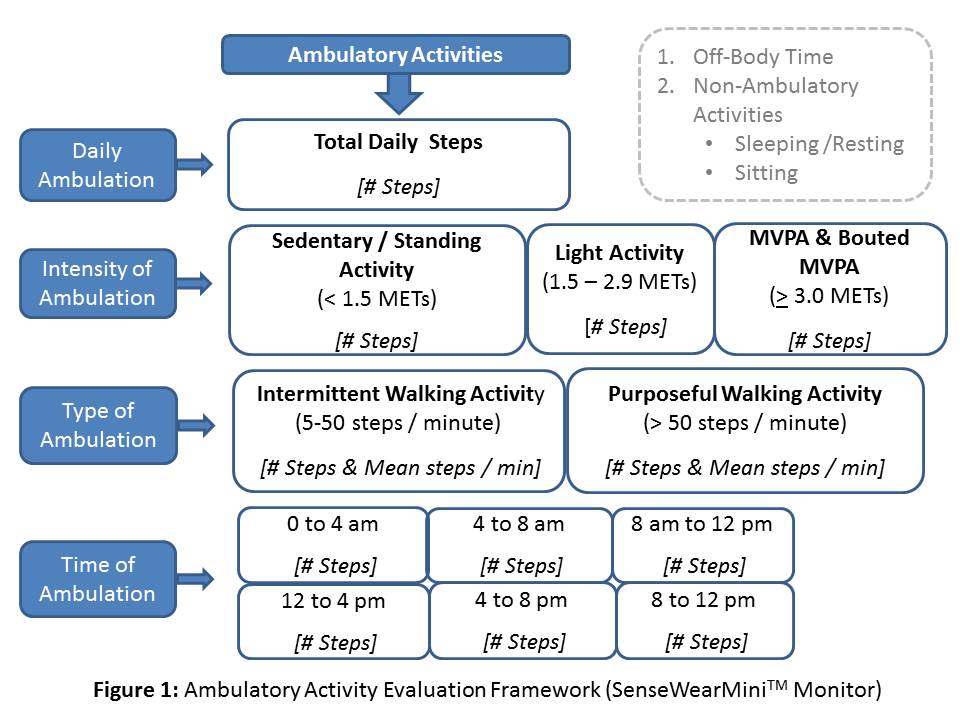Session Information
Date: Wednesday, November 11, 2015
Title: ARHP V: Physical Activity
Session Type: ARHP Concurrent Abstract Session
Session Time: 9:00AM-10:30AM
Background/Purpose:
Measures of daily steps does
not allow for examination of how steps are accumulated from different type or
intensity of ambulatory activity, which is important information for designing
physical activity interventions to support people living with arthritis to be
more physically active. Our study aimed to: 1) introduce an approach for more
comprehensive evaluation of ambulatory activities using Sensewear Mini TM
(SW) monitor data, and 2) demonstrate how this analytical approach could be
used to explore differences in intensity of ambulation across 1-year in people
living with and without early rheumatoid arthritis (RA).
Methods: RA
participants had a physician diagnosis of RA within the last year and were
matched with age and gender peers living without RA. All participants wore the
SW monitor for 7-days at baseline and 12 months later. Off body and non-ambulatory
minutes are excluded to allow for evaluation of minutes of ambulatory activity,
including: 1) daily ambulation, 2) intensity of ambulation, 3) type of
ambulation, and 4) time of ambulation (Figure 1). To
demonstrate how this analytical approach could be used we explored difference
in daily ambulation and intensity of ambulation with Paired T-tests at baseline
and 12 month follow up.
Results: At baseline RA participants
[n=27, Age: mean 53 y (21-73 y). Female: 22] acquired significantly fewer total
daily steps than their peers (n=27). However,
when examined across intensity of activity RA participants actually had
markedly more steps acquired from sedentary and light ambulatory activity and significantly
fewer steps from moderate to vigorous intensity ambulatory activity. One year later differences in total daily
steps between RA and Non-RA participants (n=46, 23 pairs) was no longer
significant. However, when examined
across intensity of activity similar trends for differences in ambulatory
activity seen at baseline remained (e.g. RA more sedentary / light vs less MVPA
steps), with the most notable difference being RA acquiring significantly more steps
from light intensity ambulatory activity (Table 1).
|
Table 1: Summary of Selected Comparisons of Ambulatory Activity (Paired T-Test, two tailed) in People Living With and Without Early Rheumatoid Arthritis (RA) [Baseline and 12-month follow up] |
||||
|
Selected Ambulatory Activity Comparison: (n=54, 27 Pairs) – Baseline |
||||
|
Ambulatory Activity Examined |
Non-RA [Mean (SEM)] |
RA [Mean (SEM)] |
* Difference (Non-RA-RA). [Mean (SEM)] |
P value |
|
Total Daily Steps (#) |
9819 (744.9) |
6855 (598.2) |
2964 (893.5) |
<0.001 |
|
Sedentary – Standing Steps (#) |
741 (88.7) |
1186 (185.1) |
– 445 (230.5) |
0.07 |
|
Light – Steps (#) |
2441 (137.5) |
3073 (312.4) |
-632 (358.0) |
0.09 |
|
MVPA 3+ METs – Steps (#) |
6581 (783.0) |
2509 (437.5) |
4072 (891.5) |
<0.001 |
|
MVPA 3+ METs Bouted (>=10 min,±2) – Steps (#) |
5540 (737.9) |
1805 (399.3) |
3735 (826.7) |
<0.001 |
|
Selected Ambulatory Activity Comparison: (n=46, 23 Pairs) – 12 Month Follow-up |
||||
|
Total Daily Steps (#) |
8716 (698.4) |
8075 (794.7) |
641 (1039.2) |
0.54 |
|
Sedentary – Standing Steps (#) |
833 (119.1) |
1080 (170.9) |
-247 (213.0) |
0.26 |
|
Light – Steps (#) |
2313 (131.2) |
3511 (400.1) |
-1198 (428.6) |
0.01 |
|
MVPA 3+ METs – Steps (#) |
5444 (723.1) |
3592 (729.3) |
1852 (1030.0) |
0.09 |
|
MVPA 3+ METs Bouted (>=10 min,±2) – Steps (#) |
4607 (672.3) |
2633 (683.5) |
1974 (939.9) |
0.05 |
|
* Negative value indicates Non-RA less than RA. No correction for multiple comparisons |
||||
Conclusion:
A more comprehensive
evaluation of ambulatory activities allows for examination of differences (or
change) in ambulatory activities that would not otherwise be detected with
measures of total daily steps. Moving
beyond measuring daily steps to evaluations of intensity, type and timing of ambulatory
activities can inform clinical and research initiatives aimed at supporting individuals
living with arthritis to move more and sit less.
To cite this abstract in AMA style:
Feehan L, McIvor J, Yoo JY, Li L. A Comprehensive Method for Using Sensewear MiniTM Monitors to Explore Differences in Ambulatory Activities in People Living with and without Early Rheumatoid Arthritis: Moving Beyond Measuring Total Steps [abstract]. Arthritis Rheumatol. 2015; 67 (suppl 10). https://acrabstracts.org/abstract/a-comprehensive-method-for-using-sensewear-minitm-monitors-to-explore-differences-in-ambulatory-activities-in-people-living-with-and-without-early-rheumatoid-arthritis-moving-beyond-measuring-total-s/. Accessed .« Back to 2015 ACR/ARHP Annual Meeting
ACR Meeting Abstracts - https://acrabstracts.org/abstract/a-comprehensive-method-for-using-sensewear-minitm-monitors-to-explore-differences-in-ambulatory-activities-in-people-living-with-and-without-early-rheumatoid-arthritis-moving-beyond-measuring-total-s/

